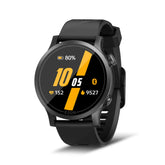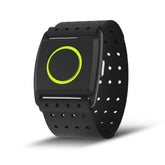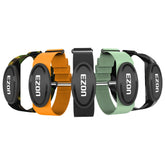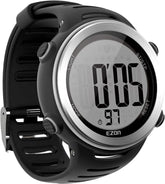Climbing Fitness Blueprint: Heartbeat Monitors & Strength Drills for Advanced Routes
Elevate your climbing from intermediate to advanced with a data-driven approach! This guide combines heartbeat monitors for precise exertion tracking and ladder running + strength drills for explosive power, helping you tackle challenging bouldering and sport climbing routes with confidence.
1. Heartbeat Monitors: Your Key to Optimal Exertion
A. Climbing-Specific Heart Rate Zones
-
Warm-Up (Zone 1–2, 50–70% Max HR):
- 10–15 minutes of easy bouldering or top-roping to raise heart rate gradually.
-
Max Effort (Zone 4–5, 80–100% Max HR):
- Bouldering projects or redpoint attempts—limit to 1–2 tries per problem to avoid lactic acid buildup.
-
Rest Intervals:
- Wait until heart rate drops to Zone 2 (60–70% HR) before repeating a route—use your monitor’s real-time alerts.
B. Exertion Tracking for Recovery
- Heart Rate Variability (HRV): High HRV (60+) signals readiness for intensity; low HRV (<40) means prioritize finger stretches over campus board training.
- Resting Heart Rate (RHR): A 5 BPM increase from baseline indicates fatigue—swap a hard session for yoga.
2. Strength Drills for Advanced Climbers
A. Ladder Running: Explosive Power for Dynos
-
How to Do It:
- Set up a 10-rung ladder on flat ground.
- Sprint forward, placing each foot in alternating ladder rungs as quickly as possible (aim for 3–4 seconds per ladder length).
- Heart Rate Focus: Keep sprints in Zone 4 (80–90% HR) for 10–15 seconds, followed by 1-minute rest (Zone 1).
- Progression: Increase ladder speed by 5% weekly, using a heartbeat monitor to ensure effort consistency.
B. Finger Strength Drills
-
Hangboard Intervals:
- 4x10-second max hangs on 20mm edges, 90-second rest (Zone 1 recovery).
- Track heart rate during rests—should drop to 60–70% HR before next set.
-
Campus Board Work:
- 3x5-rung ascents with controlled descents, focusing on explosive pulls (Zone 5 effort).
C. Core Strength for Body Tension
- Deadhang Leg Raises: 3x12 reps, holding at the top for 2 seconds—use a watch timer to ensure proper form.
- Dynamic Plank Twists: 2x30 seconds/side, maintaining a steady heart rate in Zone 2.
3. Advanced Route Training Strategy
A. 8-Week Progression Plan
Weeks 1–2: Base Strength
- Focus: Ladder runs (3x/week) + hangboard training (2x/week).
- Heart Rate Goal: Keep 80% of drills in Zone 3–4 (70–90% HR).
Weeks 3–5: Power-Endurance
- Focus: Sport climbing routes at 70–80% of your redpoint grade, 4x/week.
- Heart Rate Insight: Aim for consistent heart rate in Zone 3 during 5-minute climbs, practicing controlled breathing.
Weeks 6–8: Project Phase
- Focus: Attempting your project route, paired with low-intensity ladder runs for maintenance.
- Recovery: Use HRV to schedule rest days—high HRV = try hard; low HRV = repeat easier routes.
B. Redpoint Strategy
- Pre-Route Warm-Up: 20 minutes of easy climbing + 3 ladder runs to prime explosive power (heart rate in Zone 3).
-
On-Route Tactics:
- First half: Maintain Zone 3 HR (70–80% MHR) for steady energy.
- Crux section: Allow heart rate to spike to Zone 4 (80–90% MHR) for short bursts, using finger strength drills to power through.
4. Recovery and Injury Prevention
A. Overtraining Signs & Solutions
| Symptom | Cause | Solution |
|---|---|---|
| Persistent finger pain | Overtrained tendons | 3 days off hangboarding + wrist stretches |
| Elevated RHR | Systemic fatigue | 24-hour rest + HRV-guided recovery |
| Poor grip strength | Lack of protein | Increase protein to 1.6g/kg body weight |
B. Sleep for Muscle Repair
- Goal: 7–9 hours/night, with 15–20% deep sleep.
- Watch Insight: Use sleep staging to adjust bedtime—aim for 10 PM lights-out to ensure 2 hours of deep sleep by 2 AM.
5. Gear for Advanced Climbers
A. Heartbeat Monitor Features
- Wrist-Based Accuracy: EZON Heart Rate Series for unobtrusive tracking during dynos and campus board sessions.
- Shock Resistance: 10ATM water resistance and rugged casing for outdoor crag use.
B. Training Accessories
- Agility Ladder: 10-rung adjustable ladder for sprint drills.
- Hangboard with Weighted Vest: Add 5–10kg for advanced finger strength training, synced with heart rate data for effort calibration.
6. Common Mistakes to Avoid
-
Skipping Warm-Up Heart Rate Checks:
- Solution: Use a heartbeat monitor to ensure warm-up heart rate reaches Zone 2 before attempting hard routes.
-
Ignoring HRV for Recovery:
- Solution: Check HRV daily—low values mean replace a power day with endurance climbing.
-
Overusing Campus Board:
- Solution: Limit to 1x/week to avoid pulley injuries, pairing with finger tendon glides (3x/day).
7. FAQs: Your Advanced Climbing Questions Answered
Q: How often should I do ladder runs?
- 2–3x/week, spaced 48 hours apart to allow leg muscle recovery.
Q: Can I use a chest-strap monitor for climbing?
- Yes, but wrist-based monitors are more convenient for dynamic movements—choose a lightweight model like EZON’s Heart Rate Series.
Q: What’s the ideal heart rate for endurance climbing?
- Zone 3 (70–80% MHR) to maintain steady energy for routes lasting 5–10 minutes.
Climb Smarter, Climb Stronger
With heartbeat monitors and targeted strength drills, you’ll transform raw power into strategic performance. Use data to gauge exertion, refine recovery, and push your limits safely, whether you’re sending V8 boulders or redpointing 5.12 sport routes.
Gear up with a reliable monitor, master ladder running for explosive power, and let every session be a step toward your next climbing breakthrough. The routes ahead are challenging, but with precision training, you’ll climb them with confidence and control.
EZON Watch: Professional sports technology brand
https://ezonwatch.com
https://ezonwatch.com









